Welcome to the world of expert grilling‚ where technique and precision transform food into masterpiece meals. Learn the fundamentals‚ safety‚ and artistry behind achieving perfection every time.
1.1. Understanding the Basics of Grilling
Grilling is a cooking method that involves exposing food to direct heat‚ typically using charcoal‚ gas‚ or wood. It enhances flavors through caramelization and smoky notes. To start‚ choose the right fuel—charcoal for smokier tastes or propane for convenience. Preheat your grill to ensure even cooking. Temperature control is crucial; use zones for searing and finishing. Essential tools include tongs‚ spatulas‚ and thermometers. Always preheat‚ oil grates to prevent sticking‚ and cook with the lid down for even heat. Safety is key: keep flammable items away and never leave the grill unattended. Mastering these basics will set you on the path to expert grilling.
1.2. Importance of Proper Grill Setup
Proper grill setup is essential for achieving optimal results and ensuring safety. Begin by preheating the grill to the desired temperature‚ allowing it to reach a consistent heat. Clean the grates thoroughly with a wire brush to remove residue and prevent sticking. Ensure the grill is level to distribute heat evenly. For charcoal grills‚ arrange coals correctly—directly under food for high heat or spread out for indirect cooking. Gas grills should have burners checked for proper ignition. Always use the right type of fuel and follow ventilation guidelines. Proper setup enhances flavor‚ prevents flare-ups‚ and ensures a safe grilling experience. Consult your grill’s manual for specific setup instructions to maximize performance.
1.3. Safety Precautions for Beginners
Safety is paramount when starting your grilling journey. Always wear heat-resistant gloves and use long-handled utensils to avoid burns. Keep a fire extinguisher nearby and ensure children and pets stay away from the grill. Never leave the grill unattended while it’s in use. For gas grills‚ check for leaks by applying soapy water to hoses and connections—bubbles indicate a leak. Charcoal grills require proper ventilation to avoid carbon monoxide buildup. Before lighting‚ ensure the grill is on a stable‚ level surface and clear of flammable materials. After grilling‚ let the grill cool completely before cleaning. Familiarize yourself with your grill’s specific safety features and follow the manufacturer’s guidelines to prevent accidents. Stay alert and prepared to handle unexpected situations promptly.
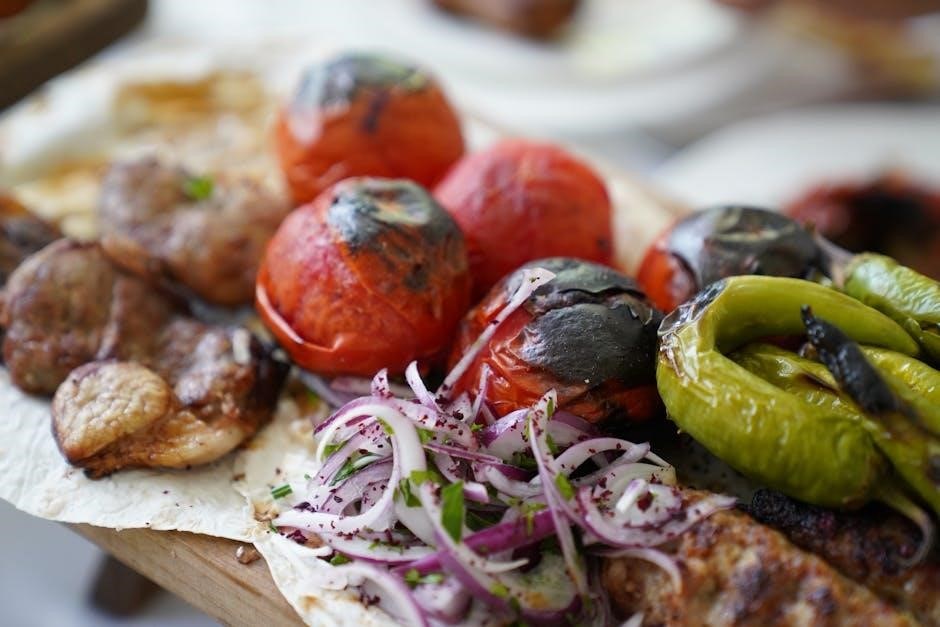
Choosing the Right Grill
Selecting the perfect grill involves considering size‚ fuel type‚ and features. Assess your space‚ budget‚ and cooking needs to make an informed decision for optimal grilling performance.
2.1. Types of Grills Available
Explore various grill types to suit your preferences. Charcoal grills offer smoky flavors‚ while gas grills provide convenience and precise temperature control. Electric grills are ideal for indoor use‚ and smoker grills excel at low-and-slow cooking. Each type has unique benefits‚ so consider your lifestyle and cooking style when choosing to ensure the best grilling experience.
2.2. Features to Look for in a Grill
When selecting a grill‚ prioritize features that enhance performance and durability. Look for high-quality burners‚ durable materials like stainless steel or porcelain-coated grates‚ and a robust ignition system. Ensure the grill has even heat distribution and adjustable temperature control for versatility. A large cooking surface and storage space are practical additions. Consider grills with advanced features like smart temperature monitoring or smoke control for expert results. Durable construction ensures longevity‚ while easy cleaning and maintenance features save time. Finally‚ check for safety features like heat-resistant handles and secure lids to ensure a safe grilling experience. These factors will help you choose a grill tailored to your needs and preferences.
2.3. Budget Considerations
Setting a budget is crucial when choosing a grill. Grills vary widely in price‚ from affordable entry-level models to high-end units with advanced features. Determine your spending limit and balance it with the features you need. Basic charcoal or gas grills can be found for under $200‚ while mid-range models with more features typically cost between $300-$700. Premium grills with smart technology or luxury materials can exceed $1‚000. Consider long-term costs‚ such as fuel and maintenance‚ to ensure your choice fits within your overall budget. Prioritizing your needs and comparing options will help you find the best value for your money and grilling goals.
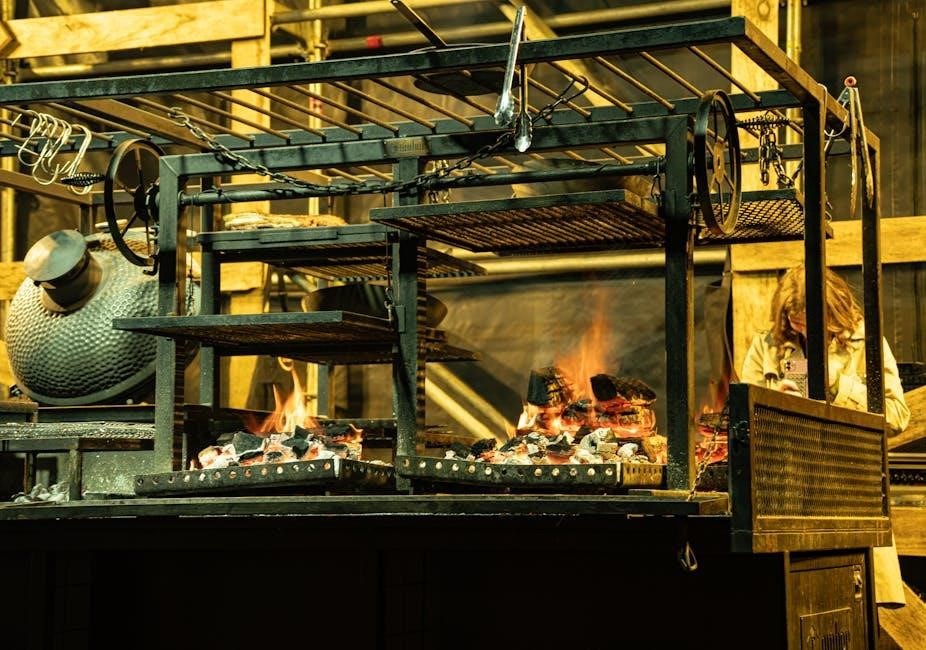
Pre-Assembly and Safety Checks
Unpack and inventory all parts‚ checking for damage. Ensure all components are included and compatible. Verify safety features‚ like proper ventilation and secure connections‚ before assembly begins.
3.1. Unpacking and Inventory
When unpacking your Expert Grill‚ carefully remove each component from the box‚ ensuring no parts are damaged. Lay out all items on a flat‚ stable surface. Check the inventory list provided in the manual to confirm all parts are included and match the listed descriptions. Pay particular attention to essential components like the grill body‚ lid‚ burners‚ and grates. If any items are missing‚ damaged‚ or mismatched‚ contact customer support immediately. Proper inventory ensures smooth assembly and avoids delays. Organize parts by category to streamline the assembly process and prevent losing small hardware pieces like screws or washers.
3.2. Initial Safety Checks
Before assembling your Expert Grill‚ perform a thorough safety inspection. Check for any visible damage‚ dents‚ or rust on the grill body‚ burners‚ or vents. Ensure all connections‚ such as gas lines or electrical components‚ are secure and free from leaks. If you notice any damage or wear‚ do not proceed with assembly. Properly inspecting your grill prevents potential hazards like gas leaks or fire risks. Use a soapy water solution to test for gas leaks if applicable. Clear any blockages in the vents or ports to ensure proper airflow. Always assemble and use your grill in a well-ventilated area‚ away from flammable materials‚ and keep a fire extinguisher nearby for emergencies.
3.3. Tools Needed for Assembly
Assembling your Expert Grill requires specific tools to ensure a smooth and safe process. Essential tools include a screwdriver (both Phillips and flathead)‚ an Allen wrench‚ and a rubber mallet for gently tapping parts into place. A pair of pliers may be useful for securing or tightening small components. Optional tools like WD-40 can help loosen stubborn parts. Always refer to the instruction manual for specific recommendations‚ as some grills may require specialized tools. Organize all hardware‚ such as nuts‚ bolts‚ and washers‚ before starting to avoid missing pieces. Keep these tools within reach to streamline the assembly process and minimize delays. Proper tools ensure a secure and correct assembly of your grill.
Temperature Control and Management
Mastering temperature control is crucial for expert grilling. Understand heat zones‚ manage distribution‚ and use thermometers to ensure precise cooking temperatures for optimal results every time.
4.1. Understanding Temperature Zones
Temperature zones are essential for expert grilling‚ allowing you to cook different foods simultaneously. Direct heat zones are ideal for high-temperature searing‚ while indirect zones provide lower heat for slower cooking.
By creating these zones‚ you can achieve perfect doneness for various cuts of meat and vegetables.
Always preheat your grill to ensure even distribution of heat.
Using a thermometer helps monitor temperatures‚ ensuring your grill operates within the desired range for consistent results.
Mastering temperature zones elevates your grilling game‚ making every meal a success.
4.2. Managing Heat Distribution
Proper heat distribution is crucial for expert grilling. Direct heat zones sear food quickly‚ while indirect zones allow for slower cooking.
Create heat zones by adjusting fuel placement—charcoal or gas burners.
Preheating your grill ensures even heat spread.
Use vents to control airflow‚ which regulates temperature.
Avoid overcrowding to prevent heat from being trapped.
Rotating food ensures consistent cooking.
For charcoal grills‚ rake coals to distribute heat evenly.
In gas grills‚ adjust burners to create temperature gradients.
Monitor heat with a thermometer for precision.
Mastering heat distribution ensures perfectly cooked dishes every time.
4.3. Using a Thermometer Effectively
A thermometer is essential for precise temperature control in grilling. Digital thermometers provide accurate readings‚ ensuring food safety and perfect doneness.
Insert the probe into the thickest part of the meat‚ avoiding fat or bone.
For grills‚ check temperature zones to maintain even heat.
Preheat your grill and verify temperature with a thermometer.
Use instant-read thermometers for quick checks.
Probe thermometers monitor temperature over time‚ ideal for slow cooks.
Infrared thermometers measure surface temps for searing.
Calibrate your thermometer for accuracy.
Understand safe internal temperatures to prevent undercooking or overcooking.
Mastery of thermometer use elevates your grilling precision and consistency.
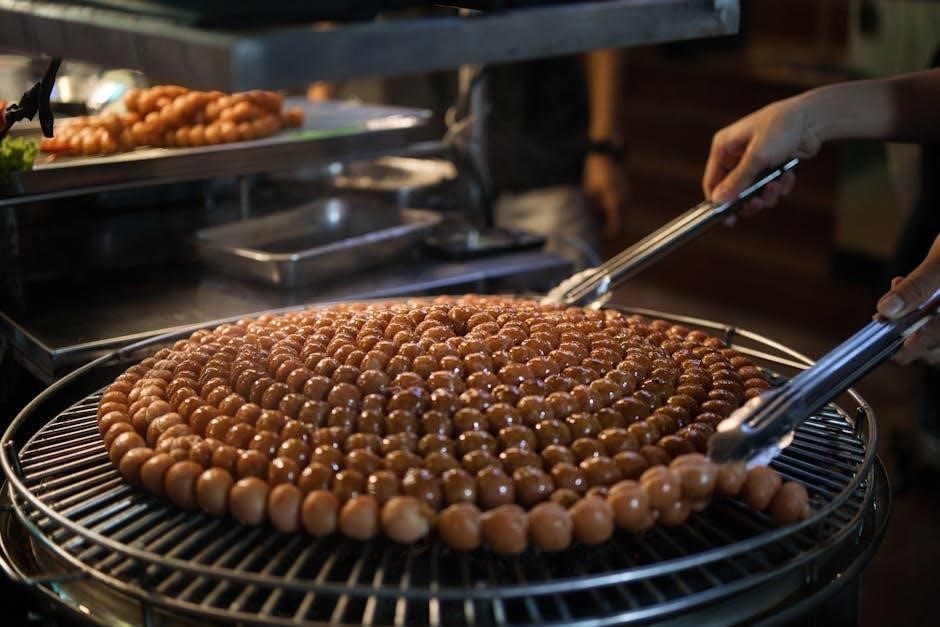
Cooking Techniques for Expert Results
Master expert grilling techniques to elevate your dishes. Understand different cuts of meat‚ smoke management‚ and achieving perfect char. Learn temperature zones‚ tool usage‚ and timing for flawless results.
5.1. Best Practices for Different Cuts of Meat
Understanding the best practices for various meat cuts is essential for expert grilling. Thicker cuts like steaks and roasts benefit from higher heat searing to lock in juices‚ while thinner cuts require lower temperatures to prevent drying. Poultry should be grilled skin-side down first to crisp the skin‚ then flipped for even cooking. For ground meats‚ forming patties with a dimple in the center helps prevent puffing. Always let meat rest after grilling to redistribute juices‚ ensuring tender and flavorful results. Use a meat thermometer to achieve perfect doneness‚ and avoid over-flipping to maintain the integrity of the meat.
5.2. Mastering Smoke and Flavor
Mastering smoke and flavor is a cornerstone of expert grilling. Different types of wood‚ such as hickory‚ oak‚ and apple‚ impart unique flavors to your dishes. Experiment with wood chips or chunks to enhance your grill’s smoke profile. For a deeper flavor‚ soak wood in water or your choice of liquid before adding it to the grill. Proper airflow is key to managing smoke effectively—adjust vents to control intensity. Pairing meats with complementary wood flavors‚ like brisket with post oak or ribs with cherry wood‚ elevates your grilling game. Don’t forget to balance smoke with direct heat to avoid overpowering your dishes. Practice makes perfect in achieving that ideal smoky flavor!
5.3. Tips for Achieving Perfect Char
Achieving perfect char requires precision and technique. Preheat your grill to high heat and ensure grates are clean and oiled to prevent sticking. Place meat gently to avoid tearing and position it at an angle for decorative marks. Allow the meat to sear undisturbed for 3-4 minutes per side to develop a deep crust. Avoid pressing down with your spatula‚ as this can push out juices and prevent even charring. For added texture‚ finish with a quick sear after cooking. Using cast iron or stainless steel grates enhances char formation due to better heat retention. Practice these steps to master the art of achieving a flavorful‚ perfectly charred finish every time.

Maintenance and Cleaning
Regular maintenance ensures your grill performs optimally. Clean grates with a wire brush‚ empty ash pans‚ and wipe down surfaces after each use. Deep clean annually.
6.1. Daily Cleaning Routines
Establishing a daily cleaning routine is essential for maintaining your grill’s performance and longevity. Start by brushing the grates with a sturdy wire brush after each use to remove food residue. This prevents stubborn stains and ensures even cooking in the future. Next‚ wipe down the exterior surfaces with a damp cloth to eliminate grease splatters and spills. For charcoal grills‚ empty the ash pan after it cools down completely to avoid any lingering embers. Gas grills should have their drip pans cleaned regularly to prevent the buildup of debris. Consistency in these simple tasks will keep your grill in pristine condition and ready for the next use.
6.2. Deep Cleaning and Sanitizing
For a deep clean‚ remove grates and burners‚ soaking them in a mixture of warm water and baking soda. Scrub tough stains with a stiff brush and rinse thoroughly; Sanitize surfaces with a food-safe cleaner or high heat. Regular deep cleaning ensures optimal performance and hygiene‚ preventing the buildup of harmful bacteria and residue.
6.3. Storage and Protection
Proper storage and protection are essential to maintain your grill’s longevity. After deep cleaning‚ ensure the grill is completely dry before storing. Use a durable‚ waterproof cover to shield it from dust‚ moisture‚ and pests. Store the grill in a dry‚ secure location‚ such as a garage or shed‚ to protect it from harsh weather. For gas grills‚ disconnect the propane tank and store it separately. Regularly inspect the cover and storage area for damage or pests. By following these steps‚ you can preserve your grill’s condition and ensure it remains ready for future use. Proper storage also enhances safety and performance.
Accessories and Tools
Elevate your grilling experience with essential tools like brushes‚ tongs‚ and thermometers. Accessories such as grill covers and smokers enhance performance and protect your investment for years.
7.1. Essential Tools for Expert Grilling
A well-stocked toolkit is crucial for expert grilling. Start with durable tongs and spatulas for flipping meats without damaging them. A meat thermometer ensures precise temperature control‚ guaranteeing perfectly cooked dishes. Grill brushes are vital for maintaining grill cleanliness and preventing food from sticking. Don’t overlook heat-resistant gloves to protect your hands from high temperatures. Additionally‚ a chimney starter simplifies charcoal ignition‚ while a grill cover safeguards your equipment from the elements. For advanced techniques‚ consider smokers or rotisseries. Each tool plays a specific role in enhancing your grilling experience and achieving professional-quality results every time you cook.
7.2. How to Use Grill-Specific Accessories
Grill-specific accessories elevate your cooking experience by adding convenience and versatility. A chimney starter simplifies charcoal ignition‚ ensuring a quick and even fire. Grill covers protect your equipment from weather damage‚ while smokers and rotisseries add unique flavors and cooking options. To use these effectively‚ follow the manufacturer’s instructions and experiment with different techniques. For example‚ a smoker box can infuse meats with rich‚ smoky flavors‚ while a rotisserie ensures even cooking for large cuts. Proper use of these accessories not only enhances flavor but also extends the lifespan of your grill. By mastering their application‚ you can achieve professional-grade results and expand your culinary creativity.

7.3. Enhancing Grill Performance
Enhancing grill performance involves a combination of maintenance‚ upgrades‚ and smart techniques. Regularly cleaning grates and burners ensures optimal heat distribution and prevents food from sticking. Upgrading to high-quality charcoal or pellets can improve flavor and burn efficiency. Using a grill mat or pizza stone enhances heat retention and prevents flare-ups. Proper air ventilation is crucial for consistent cooking‚ so ensure vents are clean and functioning. Additionally‚ preheating the grill for at least 15 minutes before cooking ensures even temperature distribution. For gas grills‚ checking and replacing worn-out heat deflectors can improve performance. By implementing these tips‚ you can maximize your grill’s potential and achieve consistently delicious results.
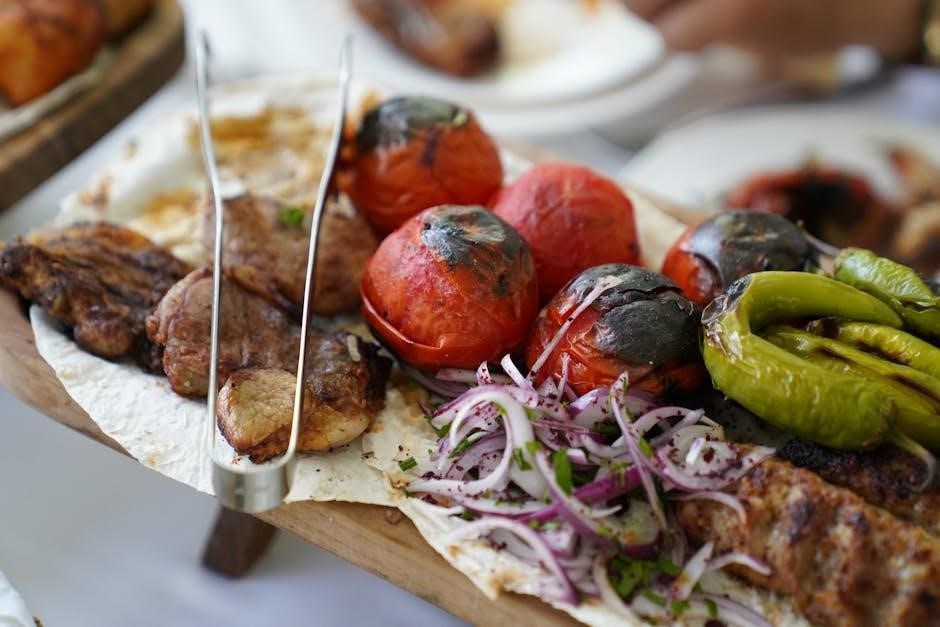
Common Issues and Troubleshooting
Address common grill issues like leaks‚ uneven heat‚ and ignition problems with quick fixes. Tighten connections‚ clean burners‚ and ensure proper gas flow for optimal performance.
8.1. Identifying and Solving Leaks
Identify leaks by inspecting gas lines‚ connections‚ and hoses for damage or wear. Use a mixture of soap and water to detect bubbles‚ which indicate leaks. Tighten loose connections or replace damaged parts. Regularly check for blockages in vents and ensure proper grill assembly. If leaks persist‚ consult a professional or refer to the user manual. Always follow safety guidelines to prevent gas-related hazards. Regular maintenance can prevent future issues and ensure safe‚ efficient grilling. Addressing leaks promptly is crucial for optimal performance and safety. Keep your grill in top condition by resolving leaks quickly and effectively.

8.2. Dealing with Uneven Heating
Uneven heating can occur due to poor air circulation‚ blocked vents‚ or improper food placement. To address this‚ ensure all vents are unobstructed and adjust them to balance heat distribution. Rotate food regularly to ensure even cooking. Preheat the grill thoroughly before cooking and use a thermometer to monitor temperature zones. Clean the grill grates and interior to prevent residue buildup‚ which can disrupt airflow. For gas grills‚ check burner performance and ensure they are free from debris. If issues persist‚ consider recalibrating or replacing damaged components. Proper maintenance and adjustments can help achieve consistent heating for better grilling results.

8.3. Fixing Ignition Problems
Ignition issues can hinder your grilling experience. Start by checking the burner ports for blockages and clean them with a small brush or toothpick. Ensure the propane tank is turned on fully and the regulator is functioning correctly. If the igniter isn’t sparking‚ try replacing the battery or cleaning the electrode. For electric ignitions‚ verify connections and test the ignition switch. If problems persist‚ replace worn-out ignition components. Regularly inspect and maintain the ignition system to prevent future issues. Proper troubleshooting and timely repairs can restore your grill’s performance and ensure safe‚ efficient grilling sessions.
Grilling mastery begins with understanding techniques and tools. Experiment with recipes‚ accessories‚ and continuous learning to elevate your skills and enjoy exceptional results every time.
9.1. Summary of Key Points
Expert grilling involves mastering the basics‚ choosing the right equipment‚ and maintaining safety. Proper setup‚ temperature control‚ and technique are crucial for achieving consistent results. Regular maintenance ensures longevity and performance‚ while accessories enhance your grilling experience. Troubleshooting common issues like uneven heating or ignition problems keeps your grill functioning optimally. Exploring additional resources and continuous learning will refine your skills. By following these guidelines‚ you can elevate your grilling game and create delicious‚ memorable meals for years to come.
9.2. Encouragement for Further Exploration
As you master the basics of expert grilling‚ remember that there’s always room for growth and creativity. Experiment with new recipes‚ explore diverse grilling techniques‚ and stay curious about innovative tools and accessories. Join online communities or forums to share experiences and learn from fellow grill enthusiasts. Don’t hesitate to try unconventional methods or ingredients to develop your unique style. Grilling is an art that evolves with practice‚ so embrace challenges and celebrate every small victory. Keep exploring‚ and soon you’ll be crafting meals that inspire others to pursue their own grilling journeys. The grill is your canvas—let your passion shine!
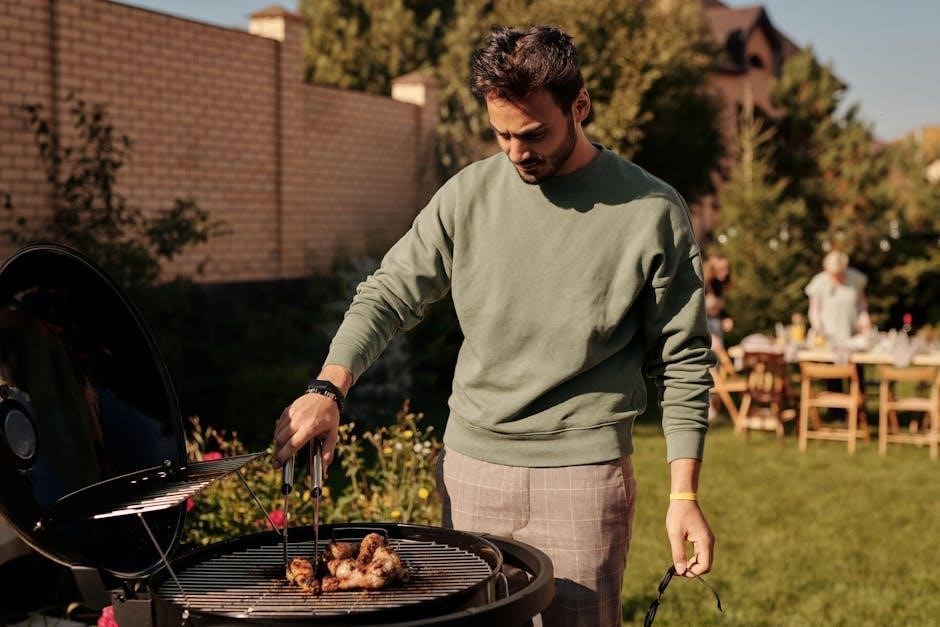
Additional Resources
Explore cookbooks‚ YouTube channels‚ and forums dedicated to grilling. Websites like Allrecipes and BBQ Bible offer expert tips‚ while communities on Reddit and Facebook share grilling experiences and advice.
10.1. Recommended Reading
For deeper insights‚ check out “The Barbecue Bible” by Steven Raichlen‚ offering comprehensive grilling techniques. “Meathead: The Science of Great Barbecue and Grilling” by Meathead Goldwyn provides a detailed‚ science-backed guide. Aaron Franklin’s “Franklin Barbecue: A Meat-Smoking Manifesto” shares expert tips for achieving smoked perfection. These books cover grilling fundamentals‚ advanced methods‚ and troubleshooting‚ ensuring a well-rounded knowledge base for grill enthusiasts. They complement online guides with in-depth‚ hands-on advice for mastering your grill.
10.2. Online Communities for Support
Joining online communities is an excellent way to connect with fellow grill enthusiasts and gain valuable insights. Platforms like Reddit‚ with subreddits such as r/BBQ and r/grilling‚ offer a wealth of knowledge‚ tips‚ and troubleshooting advice. YouTube channels like Malcom Reed’s How to BBQ Right and BBQ with Franklin provide video tutorials and expert guidance. Specialized forums like BBQ Brethren and Kamado Guru host detailed discussions on grilling techniques‚ accessory recommendations‚ and common challenges. Facebook groups dedicated to grilling also foster active discussions and real-time support. Engaging with these communities can enhance your grilling skills and help you overcome obstacles‚ making them invaluable resources for both beginners and seasoned grillers.
10.3. Expert Tips and Tricks
Expert grillers swear by several key strategies to elevate your cooking. Always preheat your grill to ensure even heat distribution and prevent sticking. Use a thermometer to maintain precise temperature control‚ especially for low-and-slow cooking. For charcoal grills‚ lighting with a chimney starter ensures a quick and even burn. Regularly cleaning grates with a wire brush prevents food residue buildup. Don’t forget to oil your grates before cooking to enhance non-stick performance. Experiment with wood chips or chunks for added smoky flavor. Store your grill properly after use to maintain its longevity. Mastering these tips will take your grilling game to the next level and ensure consistent‚ delicious results every time.


